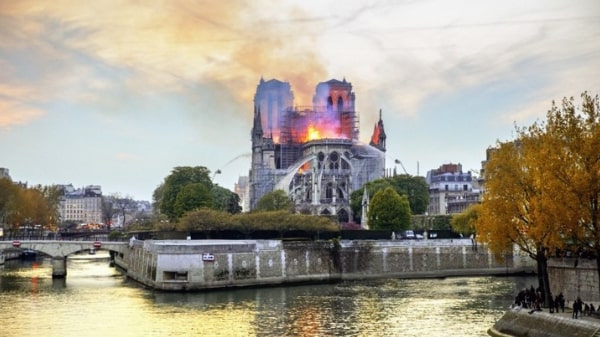
Flawed restorations that have marred the world’s best-loved monuments
Just over three months ago, one of France’s most iconic buildings – the Notre-Dame de Paris – was almost lost forever as flames threatened to consume this truly great cathedral. One of the most recognisable structures of the Parisian skyline, it wasn’t the first time the 900-year-old landmark had been minutes from disaster. During its long history, several blazes had scarred a number of its sections, while over-enthusiastic peasants, emboldened by the French Revolution, had once set about ransacking a vestibule or two.

Response to this latest calamity was swift and unremittingly generous, with many of France’s richest families – including the billionaires behind the LVMH Group, Kering and L’Oreal – pledging millions for its restoration. Despite there being no shortage of available funds, as yet there is no consensus on how best to return the building to its former glory. Indeed, the French Senate’s only rather vague guideline is that the rebuilt Notre-Dame really ought to resemble the “last visual statement” of its pre-conflagration incarnation. Meanwhile, Emmanuel Macron, the French President, has insisted that any restoration must be completed by 2024, the year the Olympic Games will be Paris-bound.

With its future form as yet unsettled, those tasked with resurrecting Notre-Dame would be well advised to learn from the monumental mistakes made by others who played fast and loose, resulting in flawed restorations of once-lost landmarks…

The Sistine Chapel
Back in the ’80s and ’90s, the ceiling of the Vatican’s Sistine Chapel underwent something of a controversial refurb. Originally completed in 1512, this 10,000sq.ft space was the work of Michelangelo, that most legendary of Italian grandmasters, but – almost 500 years on – its biblical frescoes were somewhat diminished by a decidedly non-divine array of peels, cracks and faded paintwork. Backed by funds from a Japanese TV corporation, a team of Italian and international art experts duly set about what, at the time, was billed as “the 20th century’s most extensive restoration project”.
The restoration soon became mired in remonstration, with critics claiming the first phase of the work had done more harm than good, as many original features – including plaster work, facial details and subsidiary figures – had been erased alongside the centuries of accumulated soot, smoke and grime. While the flawed restorations were ultimately grudgingly credited with reviving some of the ceiling’s original colouring, to many, what remained was a pale shadow of Michelangelo’s original artistic vision. Fail.

The Taj Mahal
India’s most must-visit monument, the Taj Mahal, was built by Shah Jahan, the Mughal emperor, as the final resting place for his wife, Mumtaz Mahal, who had died mid-childbirth at the age of just 38. Completed in 1653, some 22 years after her death, this repository is now a UNESCO World Heritage Site, with its white marble mausoleum, minarets, reflection pool and gardens attracting more than three million tourists every year.
Time, though, has not been kind to the 240ft Taj. Nor has the high level of pollution in nearby Agra. The locals’ enthusiasm for burning all things dungy and surplus-to- requirements nearby hasn’t done it any favours either. With its once-gleaming white walls now dulled, India’s Supreme Court was finally prompted into action, insisting that the government either “shut down the Taj, demolish it or restore it”.
The authorities naturally plumped for renovation. Accordingly, a lengthy restoration process is now underway, one that will see the mausoleum enclosed in a head-to-toe mud mask. It will then emerge, butterfly-like, from its cleansing cocoon with gleaming white walls and the kind of minarets you could eat your dinner off. Hmm, frankly, the jury is still out on this one… Judgement pending.

Abu Simbel
Arguably, the greatest restoration success story of all time relates to the 1964 dismantling and reassembly of Egypt’s 3,000-year-old Abu Simbel temple complex. Originally carved into the mountains of the Nubian Valley during the reign of Ramesses the Great (1279– 1213 BC), as a monument to himself and Nefertiti, his consort, the structure gazed out across the Nile for countless centuries as civilisations rose and fell around it. At least, it did until 1959.
That was the year when construction of the Aswan Dam was given the go-ahead – a massive structure that would reduce the risk of floods, boost water conservation and provide much-needed hydroelectric power. In fact, the only downside of the project was that it would see one of Egypt’s best-preserved heritage sites submerged 83ft below the surface of Lake Nasser, the vast reservoir that would subsequently be created.

Unwilling to perpetrate such an act of desecration, the Egyptian government of the day enlisted the help of UNESCO. Thus began an unprecedented collaborative venture that saw the whole of the temple painstakingly rebuilt on a new site, one that was some 65m higher, 200m further inland and likely to be a whole lot drier over the long term.
This was one immense restoration undertaking. Not only did it require the careful dissection and relocation of hundreds of 20-30-tonne rock structures, but the whole complex also had to be reconstructed exactly as it was before. In the end, the process took five years to complete and cost about US$182 million in today’s currency. It was money well spent, however, and Abu Simbel remains the gold standard for any restoration work, with those tasked with rebuilding Notre-Dame advised to follow its playbook, rather than the flawed restorations of the Not So Great Wall or the Stop and Desistine Chapel…
Text: Tenzing Thondup
Photos: AFP







